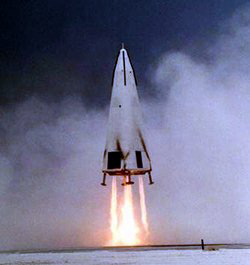Tourism Update: Jeff Bezos? Spaceship Plans Revealed

The public space travel business is picking up suborbital speed thanks to a variety of private rocket groups and their dream machines.
Joining the mix is Blue Origin's New Shepard Reusable Launch System. It is financially fueled by an outflow of dollars from the deep pockets of billionaire Jeff Bezos, founder of Amazon.com.
The Bezos-backed Blue Origin, LLC commercial space outfit has recently turned in a draft environmental assessment (EA) for their West Texas launch site to the Federal Aviation Administration's (FAA) Associate Administrator for Commercial Space Transportation (AST) in Washington, D.C.
The document is the best glimpse yet of what Blue Origin is scoping out to develop "safe, inexpensive and reliable human access to space."
Privately-owned property
The more than 200-page draft EA is a necessary step required by the FAA/AST for Blue Origin to get the needed permits and/or licenses to fly their rocket hardware.
Blue Origin proposes to launch its reusable launch vehicles (RLVs) on suborbital, ballistic trajectories to altitudes in excess of 325,000 feet (99,060 meters) from a privately-owned space launch site in Culberson County, Texas.
Breaking space news, the latest updates on rocket launches, skywatching events and more!
As outlined in the EA, the Blue Origin launch site would be approximately 25 miles (40.2 kilometers) north of Van Horn, Texas. It lies within a larger, privately-owned property known as the Corn Ranch. Access to the proposed launch site is from Texas Highway 54, which is approximately five miles (8 kilometers) west of the proposed project's center of operations.
Also on the group's to do list at the site is putting in place a vehicle processing facility, a launch complex and vehicle landing and recovery area, as well as an astronaut training facility, and other minor support amenities [Map].
Incremental testing
The strategy is to build the New Shepard suborbital vehicle incrementally, starting with low-altitude tests, progressing to higher-altitude testing, and culminating with commercial flights. Early testing would use prototype vehicles that are smaller and/or less capable than the proposed final design.
Prototype craft would use the same or a subset of the same types of propellants as the operational New Shepard RLV in smaller quantities and would use the same ground facilities, infrastructure, and equipment.
Each new trial product would fly to higher altitudes and/or demonstrate additional subsystems than the previous prototype. Eventually, Blue Origin proposes to perform multiple flight tests of the actual operational New Shepard RLV system carrying Blue Origin personnel before commencing commercial operation.
As detailed in the EA, the New Shepard RLV system would be comprised of a propulsion module and a crew capsule capable of carrying three or more space flight participants on roundtrip treks from the ground to the edge of space. The crew capsule is perched on top of the propulsion module. The stacked vehicle would have a roughly nose cone shape with a base diameter of approximately 22 feet (7 meters) and a height of approximately 50 feet (15 meters).
The propulsion module would be fully reusable, would carry its own avionics, and would operate autonomously under the control of on-board computers. The propulsion module would use 90 percent concentration hydrogen peroxide, called high test peroxide (HTP) and rocket propellant (RP) grade kerosene as the propellants.
During an abort situation, the crew capsule would separate, using small solid-rocket motors to safely recover the space flight participants. The abort module containing the solid-rocket motors would then jettison from the crew capsule. After the crew capsule departs, the propulsion module would attempt to steer back to the landing pad using aerodynamic surfaces and utilize its engines to make a controlled, powered vertical landing.
Because Blue Origin's launch vehicle would ascend and descend vertically, sonic booms would propagate away from the Earth's surface during launch and towards terra firma during descent.
Powered landing
The New Shepard test pad would be up to 32,292 square feet (3,000 square meters) in area. A separate flat landing pad of equal size would be located 3.8 miles (6.1 kilometers) north of the Blue Origin vehicle processing facility.
The New Shepard RLV launch, flight, and landing activities would require less than a 10 minute period to complete. Powered to roughly 125,000 feet (38,100 meters) under thrust from its main engines, the spaceship would chalk up some 110 seconds of flight. From there, the RLV would coast up to a height greater than 325,000 feet (99,060 meters). At top altitude, the vehicle would then return to the landing pad under gravity free-fall conditions until the main engines are restarted to enable a powered landing.
Blue Origin has not completed development of the New Shepard vehicle or its engines, according to the EA, so no test results are available. Nevertheless, as stated in the document, a thrust of 230,000 pounds force is expected at vehicle liftoff.
Blue Origin would ship the New Shepard propulsion module and crew capsule RLVs to the West Texas Launch Site separately. The RLVs would originate at Blue Origin's manufacturing and assembly facilities in the state of Washington and would travel via ground to West Texas. Blue Origin plans no more than ten total RLV shipments during the five-year period from 2006-2010.
Flight rate
Blue Origin has outlined within the pages of the EA the following activities envisioned at the West Texas launch site over the next five years. These are:
- 2006: The majority of facility construction at the site would occur during this period. In the third and fourth quarters of 2006, Blue Origin would ship the first prototype low-altitude test vehicle to the site and conduct the first flight tests. Ten or fewer flight tests could be conducted in 2006, each to an altitude of approximately 2,000 feet (610 meters) for less than one minute.
- 2007-2009: Continued flight testing of prototype vehicles with incrementally increasing capability. During these years, Blue Origin proposes to gradually expand the operational envelope of its vehicles, conducting 25 or fewer launches per year. A wide range of tests are anticipated, ranging in altitude from under 2,000 feet (610 meters) to greater than 325,000 feet (99,060 meters), lasting one minute or less to over 10 minutes. Development tests of the crew capsule abort system would be conducted during this time frame. During this time period, some construction to upgrade the facility would also occur, adding additional infrastructure to support the increasing capabilities of the system.
- 2010 and beyond: Commercial operations may commence with the operational New Shepard vehicle in this timeframe. The flight rate would depend on market demand, but Blue Origin anticipates rates up to approximately 52 launches per year of the New Shepard RLV.
According to the EA, an experimental permit from the FAA would allow Blue Origin to carry out testing of reusable suborbital vehicles that would be launched or reentered solely for: Research and development to test new design concepts, new equipment, or new operating techniques; showing compliance with requirements as part of the process for obtaining a license; and crew training prior to obtaining a license for a launch or reentry using the design of the rocket for which the permit would be issued.
Public comment
Last year, on June 14 and 15, Blue Origin conducted a series of information meetings in Van Horn, Texas and Dell City, Texas. The firm's plan to construct and operate a commercial launch facility in Culberson County, Texas was detailed at those gatherings.
Now the Draft Environmental Assessment for the Blue Origin West Texas Commercial Launch Site has been released for public review and comment, explained James Stasny, spokesman for the FAA's Office of Commercial Space Transportation.
A paper copy of the draft is available at the Van Horn public library in Van Horn, Texas. A public hearing on the Blue Origin EA will be held on July 25th at the Van Horn Convention Center, with the public comment period about the rocket group's plans closing two days later, Stasny told SPACE.com.
When queried by SPACE.com about their environmental assessment, Blue Origin declined to comment beyond what is detailed within their EA document.
Thrust vectoring and responsive throttling
Blue Origin's spaceship is patterned after Department of Defense/NASA work on the single-stage vertical-takeoff, vertical-landing Delta Clipper Experimental (DC-X) and Delta Clipper Experimental Advanced (DC-XA). It was repeatedly flown in 1993-1996 at the U.S. Army's White Sands Missile Range in New Mexico.
Among a list of distinctions, a 26-hour turnaround was achieved between the DC-XA's second and third flights - a first for any rocket. The flight program ended in July 1996 with the DC-XA suffering severe damage due to a landing strut - one of four-that failed to extend. The unbalanced vehicle tipped over on its landing pad and caught fire. Due to lack of follow-up money, the program was ended.
John Garvey was the flight engineer during the DC-XA phase of testing and now runs Garvey Spacecraft Corporation in Long Beach, California. He told SPACE.com that he's keeping an eye on how Blue Origin operates New Shepard in light of what was learned during DC-X/XA testing.
Garvey advised that if the descent and landing techniques for New Shepard are similar to those employed on the DC-X/XA, then both thrust vectoring and responsive throttling of the vehicle's engines will be required. That likely means, he added, Blue Origin engineers will spend loads of time on the test stand to flight qualify the spaceship's rocket motors, especially for human-carrying operations.
Unique hazards
"Their reported choice of hydrogen peroxide and RP-1 as propellants is interesting, particularly the hydrogen peroxide," Garvey noted. By comparison, the DC-X/XA used liquid oxygen and liquid hydrogen.
"Numerous new entrants to the rocket business have favored-at least initially - hydrogen peroxide as an oxidizer instead of liquid oxygen, usually for perceived safety reasons, even though that means sacrificing performance," Garvey observed.
However, highly concentrated hydrogen peroxide presents some unique hazards relative to liquid oxygen in flight operations as well as shipping and storage, Garvey said. Hydrogen peroxide can "rapidly decompose" if contamination is present.
"Every so often there is a story about an amateur rocketeer burning down the garage-or worse-due to such an accident," Garvey explained. "For whatever reason ... no major operational launch system has employed it for primary propulsion."
- Space Tourism: A Multimedia Special Report
- Details Emerge on Jeff Bezos' Space Plans
- Floating Robotic Spheres: From the Millennium Falcon to the ISS
- The Grand SLAM: Rocketing Water to the Moon
- Daily Space Trivia

Leonard David is an award-winning space journalist who has been reporting on space activities for more than 50 years. Currently writing as Space.com's Space Insider Columnist among his other projects, Leonard has authored numerous books on space exploration, Mars missions and more, with his latest being "Moon Rush: The New Space Race" published in 2019 by National Geographic. He also wrote "Mars: Our Future on the Red Planet" released in 2016 by National Geographic. Leonard has served as a correspondent for SpaceNews, Scientific American and Aerospace America for the AIAA. He has received many awards, including the first Ordway Award for Sustained Excellence in Spaceflight History in 2015 at the AAS Wernher von Braun Memorial Symposium. You can find out Leonard's latest project at his website and on Twitter.
